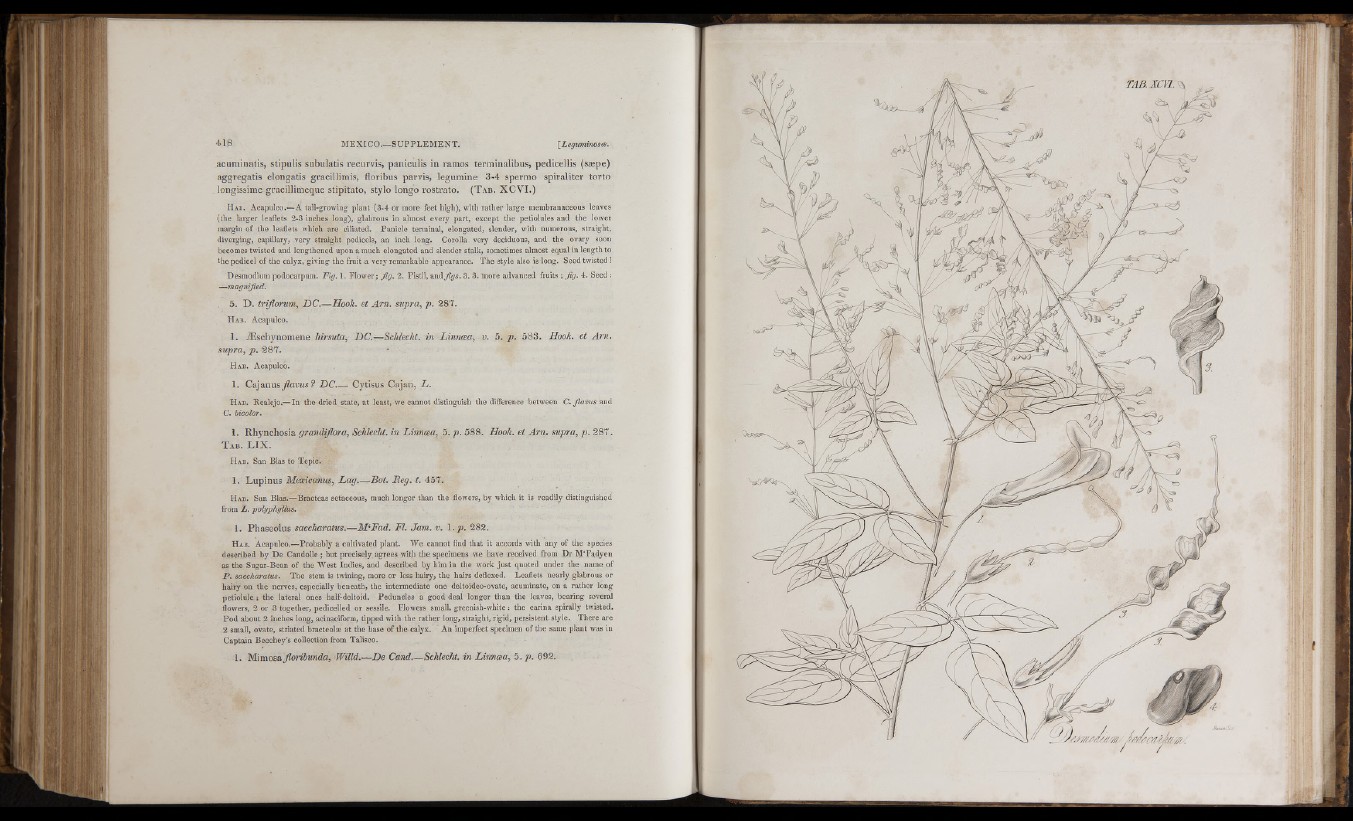
1 4 , , ■ ... «
If
J l i ; :
' l é
a cuminatis, stipulis subulatis recurvis, paniculis in ramos terminalibus, pedicellis
aggreg.atis eiongatis gracillimis, floribus parvis, legumine 3-4 spermo sp ira liter torto
longissime gracillimeque stipitato, stylo longo ro strato . (T ab. X C V I .)
H ab. Acapulco.—a tall-growing plant ( 3 -4 or more feet high), with rather large membranaceous leaves
(the larger leaflets 2 -3 inches long), glabrous in almost every part, except the petiolules and the lower
margin of the leaflets which are ciliated. Panicle terminal, elongated, slender, with numerous, straight,
diverging, capillary, very straight pedicels, an inch long. Corolla very deciduous, and the ovary soon
becomes twisted and lengthened upon a much elongated and slender stalk, sometimes almost equal in length to
the pedicel of the calyx, giving the fruit a very remarkable appearance. The style also is long. Seed twisted !
Desmodium podocarpum. Fft?. 1. F low er;/<?. 2. Pistil, a n d 8. 3. more advanced fru its ;/!? , 4 . Seed:
—magnified.
5. D. triflorum, D C .—Hook, et A rn . supra, p . 287.
H a b . Acapulco.
1. Æschynomene hirsuta, D C .—Schlecht. in Linncea, v. 5. p . 5 83. Hook, et A rn .
supra, p . 287.
H a b . Acapulco.
1. Cajanus fla v u s ? D C .— Cytisus Caj;
H a b . Realejo.—In the dried state, at least, we cannot distinguish the difference between C. flavus and
C. bicolor.
I . Rhynchosia grandifiora, Schlecht. in Linnæa, 5. p . 588. Hook, et A rn . supra, p . 2 87.
T a b . L IX .
H a b . San Bias to Tepic.
1. Lup in u s Mexicanus, L a g .— Bot. Reg. t. 457.
H a b . San Bias.—Bracteas setaceous, much longer than the flowers, by which it is readily distinguished
from L . polyphyllus.
1. Phaseolus saccharatus.— M^Fad. Fl. Jam. v. 1. p . 282.
H a b . Acapulco.— Probably a cultivated plant. We cannot find that it accords with any of the species
described by De Candolle ; but precisely agrees with the specimens we have received from Dr M‘Fadyen
as the Sugar-Bean of the West Indies, and described by him in the work just quoted under the name of
P . saccharatus. The stem is twining, more or less hairy, the hairs deflexed. Leaflets nearly glabrous or
hairy on the nerves, especially beneath, the intermediate one deltoideo-ovate, acuminate, on a rather long
petiolule ; the lateral ones half-deltoid. Peduncles a good deal longer than the leaves, bearing several
flowers, 2 or 3 together, pedicelled or sessile. Flowers small, greenish-white : the carina spirally twisted.
Pod about 2 inches long, aeinaeiform, tipped with the rather long, straight, rigid, persistent style. There are
2 small, ovate, striated bracteolæ at the base of the calyx. An imperfect specimen of the same plant was in
Captain Beechey’s collection from Talisco.
1. Mimosa/o riô tmrfa, Willd.—D e Cand.—Schlecht. in Linnæa, 5. p . 692.